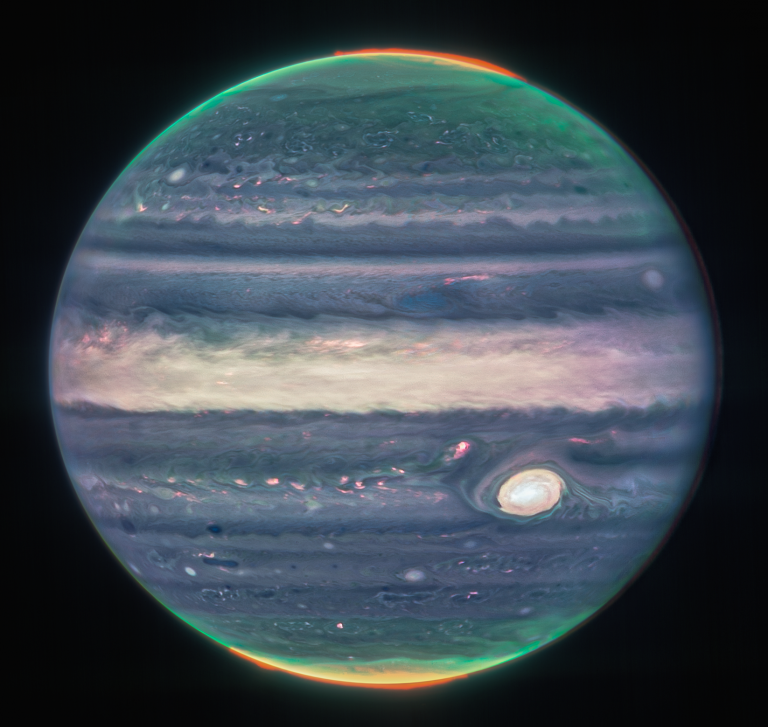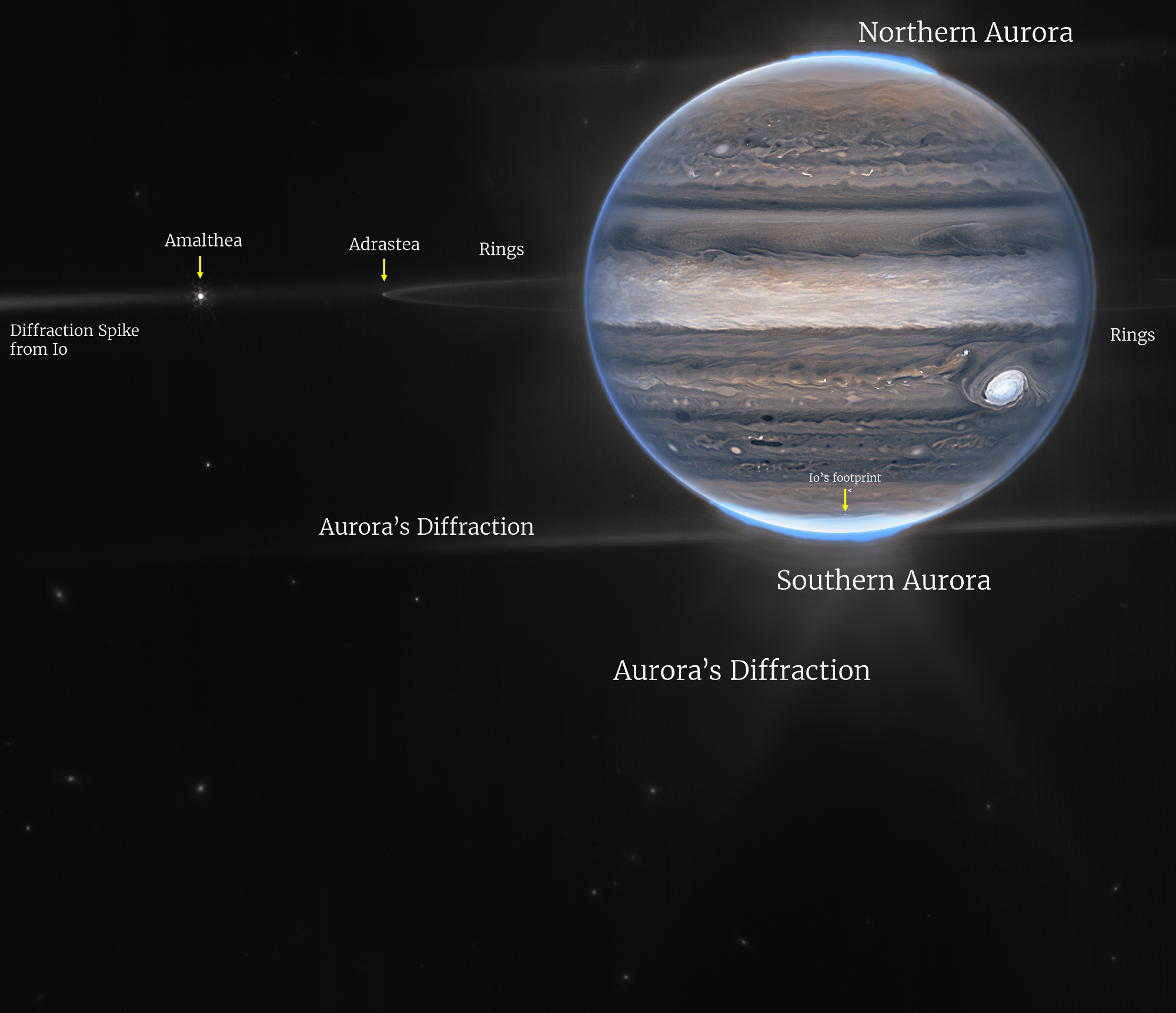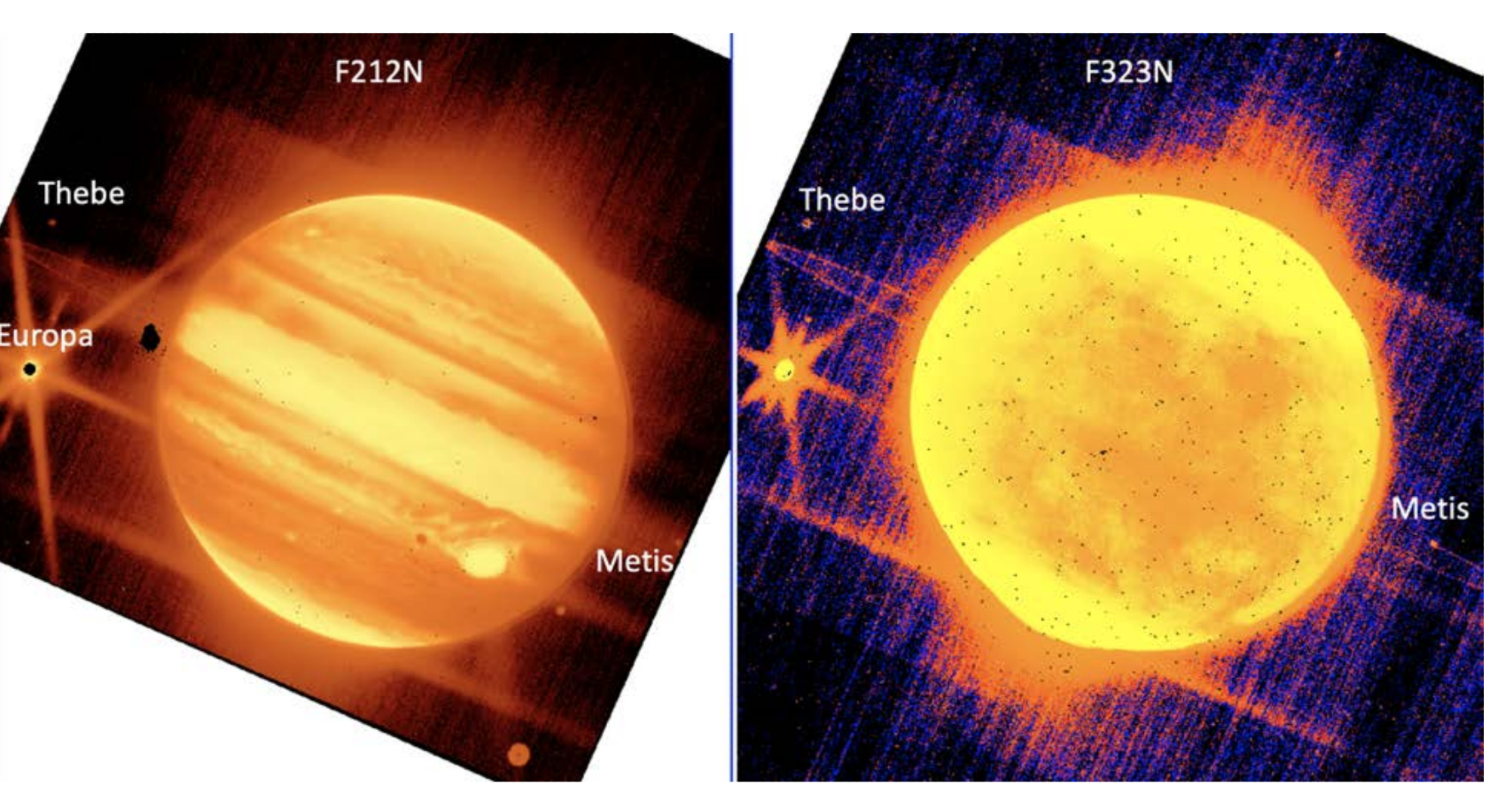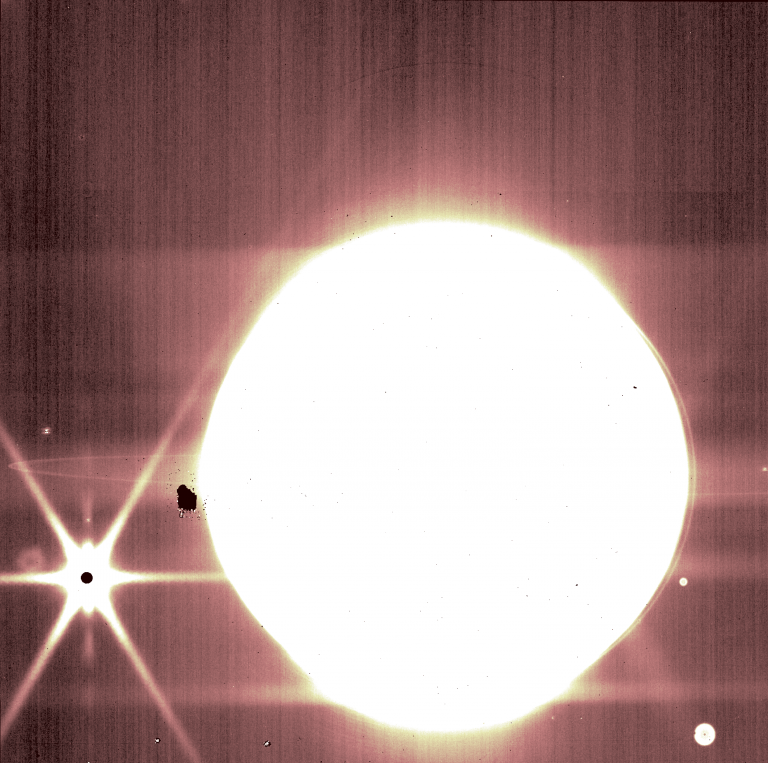The most powerful telescope ever launched into space has shed new light on the solar system’s largest planet.

JWST_2022–07–27_Jupiter-768x728. A composite image of Jupiter constructed from three JWST filters. Image Credit: NASA, ESA, CSA, Jupiter ERS Team; image processing by Judy Schmidt.
The James Webb Space Telescope (JWST) is making waves in astronomy by imaging cosmic objects at unimaginably great distances. Though the instrument is powerful enough to capture galaxies as they existed 13.5 billion years ago when our galaxy was just 300 million years old, it is also demonstrating its versatility by imaging objects much closer to home.
Acting as striking examples of this are the recent images the JWST has been able to capture of the solar system’s largest planet, the gas giant Jupiter.
The Secret Life of Jupiter
With a radius of almost 44,000 miles, over 11 times that of Earth, and a mass of around 1.9 x 1⁰²⁷ kilograms, 318 times that of our planet, Jupiter dominates the inner solar system. Yet there is a great deal that researchers still don’t know about the gas giant.

JWST_2022–07–27_Jupiter_2color_labels-1. JWST image shows the Auroras of Jupiter. Image Credit: NASA, ESA, CSA, Jupiter ERS Team; image processing by Judy Schmidt.
Currently, scientists think Jupiter has an atmosphere of mainly hydrogen and helium. Investigations of the gas giant by the JWST could better reveal the composition of the Jovian atmosphere.
As a gas giant, Jupiter lacks a solid surface, but its gaseous body increases in density with depth. Planetary scientists are hoping that data from the JWST will also help them understand the temperature at every level of this atmosphere.
The planet is home to powerful winds, auroras, extreme temperatures, and giant storms — the most famous of which is the ‘Great Red Spot’ which has been raging for hundreds of years and is wide enough and deep enough to swallow the Earth.
Data from the JWST could help researchers better understand the dynamics of these storms, namely how they are kick-started and how they rise through the atmosphere.
The JWST is already beginning to give researchers a more detailed picture of Jupiter and its ‘inner life.’
What Do the Latest JWST Jupiter Images Show?
The two latest images of Jupiter taken by the JWST — coming from the space telescope's Near-Infrared Camera (NIRCam) — have surprised astronomers thanks to their sheer detail and the wealth of phenomena and objects visible in them.

An early image of Jupiter by the JWST shows the moons Europa, Thebe, and Metis. Image Credit: NASA, ESA, CSA, and B. Holler and J. Stansberry (STScI)
In particular, Imke de Pater, professor of Astronomy, Earth and Planetary Science at the University of California, remarks that seeing the details of Jupiter along with its rings, tiny satellites, and even galaxies in one image, is particularly remarkable.
The image of Jupiter alone shows auroras extending to high altitudes above both the north and south pole of the gas giant. The different specialized infrared filters of NIRCam show different aspects of the auroras with all the images recalibrated to visible light.

JWST_2022–07–27_Jupiter-768x728. A composite image of Jupiter constructed from three JWST filters. Image Credit: NASA, ESA, CSA, Jupiter ERS Team; image processing by Judy Schmidt.
The filter that is mapped to redder regions of the electromagnetic spectrum shows the shine of the auroras and hazes in the planet’s upper atmosphere as well as light reflected from clouds lower in Jupiter’s atmosphere.
Another filter — mapped to yellows and greens — shows hazes as they swirl around both of the Jovian poles. The third filter, mapped to the bluer colors, shows light reflected by the main cloud lower in Jupiter’s atmosphere.
The Great Red Spot — considered the solar system’s largest storm — can be seen in the image, albeit uncharacteristically white. This is the result of the fact the storm is reflecting a great deal of sunlight. Some of Jupiter’s other clouds are similarly washed of color for the same reason.
As high-altitude clouds are more likely to reflect a lot of sunlight, this means the image of Jupiter is awash with bright white spots and streaks that are most likely high-altitude cloud tops of condensed convective storms.
The image shows a different situation north of Jupiter’s equator, however. This region is marked by darker streaks meaning this area very likely has little cloud cover.
The Rings and Moons of Jupiter
While Jupiter’s fellow solar system gas giant Saturn has the most famous ring system, we have been aware of Jupiter's rings since Voyager 1 made a fly-by of the larger gas giant in 1979.
These faint and nebulous rings are most visible when lit by the sun, from behind the gas giant, or in infrared. That’s where the JWST comes in.
The new wide-field image of Jupiter shows its rings — estimated to be a million times fainter than the planet itself — and demonstrates the capability of the JWST in helping astronomers study their composition and chemistry.
Currently, astronomers believe that one of the main differences between Jupiter’s rings and those of Saturn is that the latter’s rings are composed of large chunks of ice and rock. Jupiter’s rings, on the other hand, seem to be comprised of dust particles — possibly hurled up by micro-meteor impacts on Jupiter’s small inner moons and captured into orbit.

Jupiter and its moons as seen by the JWST’s NIRCam’s 3.23 micron filter. Image Credit: NASA, ESA, CSA, and B. Holler and J. Stansberry (STScI)
Also visible in the wide field image are the tiny inner Jovian moons Amalthea and Adrastea.
Astronomers think that there are at least 79 Jovian moons, 26 of which don’t even have names yet, with its four largest moons — referred to as ‘the Galilean satellites’ after Italian astronomer Galileo Galilei — being Io, Europa, Ganymede, and Callisto.
The study of all of these moons could be crucial to understanding how bodies like moons and planets grow through the accumulation of material, but Europa is of particular interest.
This is because Europa has twice as much water as Earth, and the water ice surface of this Jovian moon is believed to possess at least one ‘habitable zone’ in which life could exist.
The JWST images arrive at Earth as raw data that takes a great deal of work to formulate into an image. These new images of Jupiter and its system are prime examples of why every moment of that effort is worth it, contributing as it does to our growing understanding of the universe.
References and Further Reading
Webb’s Jupiter Images Showcase Auroras, Hazes, NASA, [Accessed 08/29/22], [https://blogs.nasa.gov/webb/2022/08/22/webbs-jupiter-images-showcase-auroras-hazes/]
How did Jupiter’s Rings Form?, Goddard Space Flight Center, [Accessed 08/29/22], [https://www.nasa.gov/centers/goddard/multimedia/largest/rings.html]
Jupiter Moons, NASA Solar System Exploration, [Accessed 08/29/22], [https://solarsystem.nasa.gov/moons/jupiter-moons/in-depth/]
Disclaimer: The views expressed here are those of the author expressed in their private capacity and do not necessarily represent the views of AZoM.com Limited T/A AZoNetwork the owner and operator of this website. This disclaimer forms part of the Terms and conditions of use of this website.